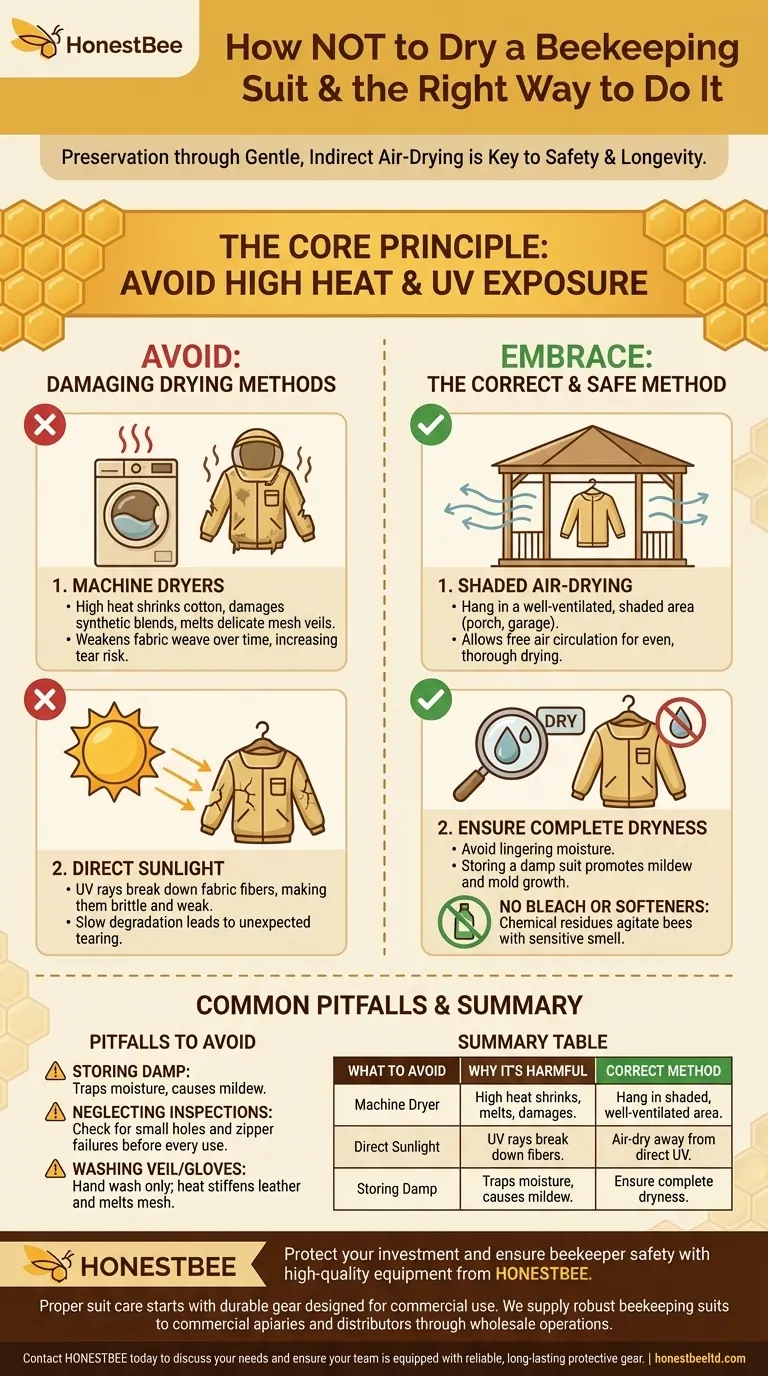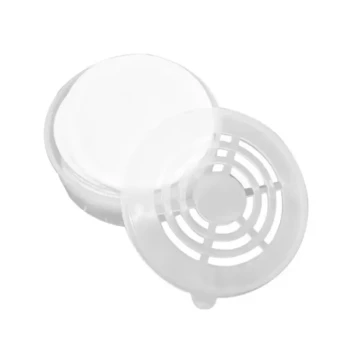To properly dry a beekeeping suit, you must avoid two specific things: using a machine dryer and hanging it in direct sunlight. Both high heat and UV exposure can damage the suit's protective fabric, compromising its integrity and shortening its lifespan.
The core principle of beekeeping suit care is preservation. Gentle, indirect air-drying is the only method that protects the specialized fabric and mesh from damage, ensuring your suit remains a reliable barrier between you and your bees.

Why Common Drying Methods Damage Your Suit
Your beekeeping suit is a critical piece of safety equipment, not just another article of clothing. Standard laundry practices can actively weaken its protective qualities.
The Problem with High Heat Dryers
Machine dryers use high heat that is detrimental to the materials in a beekeeping suit. This heat can cause cotton to shrink, damage synthetic blends, and warp or melt the delicate mesh of the veil.
Over time, this repeated heat exposure weakens the fabric's weave, making it more susceptible to tears and punctures.
The Dangers of Direct Sunlight
Exposing your suit to direct sunlight is equally damaging. The sun's ultraviolet (UV) rays break down the fibers in the fabric, causing them to become brittle and lose their strength.
This UV degradation is a slow process, but it ultimately leads to a suit that can tear unexpectedly, creating a serious safety risk.
The Correct Method for Safe Drying
Properly drying your suit is simple and requires no special equipment, only a bit of patience. The goal is to remove moisture without introducing damaging elements like heat or UV light.
Embrace Shaded Air-Drying
The ideal method is to hang your suit to dry in a well-ventilated, shaded area. This could be a covered porch, a garage with good airflow, or even a laundry room.
Hanging allows air to circulate freely around the entire suit, ensuring it dries evenly and thoroughly.
Avoid Lingering Moisture
Before storing, ensure the suit is completely dry. Storing a suit that is even slightly damp can lead to the growth of mildew and mold, which degrades the fabric and can be difficult to remove.
Prepare the Suit Properly
Proper drying begins with proper washing. Never use bleach or fabric softeners, as chemical residues can linger in the fabric. Bees have a highly sensitive sense of smell and may perceive these chemical traces as a threat, leading to agitation and defensive behavior.
Common Pitfalls to Avoid
Beyond the drying process itself, several related mistakes can compromise your suit's effectiveness and your safety.
Storing a Damp Suit
Never store a suit in a damp basement or sealed container immediately after use. This traps moisture against the fabric, creating a perfect environment for mildew that will permanently damage the material.
Neglecting Regular Inspections
A clean and dry suit is not necessarily a safe one. Before every use, perform a thorough inspection for any small holes, tears, or failing zippers. A small breach is all a bee needs.
Washing the Veil or Leather Gloves
The veil's mesh and any leather components, like gloves, should not be machine washed or dried. The mesh is too delicate, and heat will cause leather to become stiff and crack. These items should be cleaned by hand and air-dried carefully.
Making the Right Choice for Your Goal
Your approach to suit care directly impacts your safety and the longevity of your equipment.
- If your primary focus is maximum safety and lifespan: Always wash your suit with a mild, unscented detergent and hang it to dry in a shaded, well-ventilated area until it is completely dry.
- If your primary focus is speed and convenience: Understand that using a dryer or direct sun is a trade-off that will degrade the fabric, shorten the suit's life, and eventually compromise its protective qualities.
Ultimately, proper care of your beekeeping suit is a direct investment in your own safety and confidence when working with your hives.
Summary Table:
| What to Avoid | Why It's Harmful | Correct Method |
|---|---|---|
| Machine Dryer | High heat shrinks cotton, damages synthetics, and melts veil mesh. | Hang in a shaded, well-ventilated area. |
| Direct Sunlight | UV rays break down fibers, making them brittle and weak. | Air-dry away from direct UV exposure. |
| Storing Damp | Traps moisture, leading to mildew and fabric degradation. | Ensure the suit is completely dry before storage. |
Protect your investment and ensure beekeeper safety with high-quality equipment from HONESTBEE. Proper suit care starts with durable gear designed for commercial use. We supply robust beekeeping suits and equipment to commercial apiaries and distributors through our wholesale operations. Contact HONESTBEE today to discuss your needs and ensure your team is equipped with reliable, long-lasting protective gear.
Visual Guide

Related Products
- Wholesales Dadant Size Wooden Bee Hives for Beekeeping
- Professional Insulated Plastic Bee Hives
- Long Langstroth Style Horizontal Top Bar Hive for Wholesale
- Automatic Honey Flow Beehive 4 Frame Mini Hive for Beekeeping
- Professional Insulated Winter Hive Wrap for Beekeeping
People Also Ask
- What is beekeeping equipment? Essential Tools for Commercial Apiaries & Distributors
- What types of products are available for beekeeping needs? Essential Equipment for Apiaries & Distributors
- What are the advantages of wooden bee hives? Superior Bee Health & Beekeeper Flexibility
- How often should the area under beehives be inspected and cleaned during the warm season? A Proactive Maintenance Guide
- What should beginners consider when purchasing beekeeping equipment? A Guide to Essential Starter Gear



















